22-tone guitar, a project begun
I yanked th frets off my Fender Stratocaster this week & started tying wires on to serve as new frets for a new tuning (!!): 22 equal divisions of th octave. Th wire frets buzz, break, & shift position when I don't want them to, but otherwise, I feel very pleased w/ how this project has turned out so far! I have started formulating plans for a multi-movement something-or-other to come.
Pix: a pile of frets on my bedroom floor: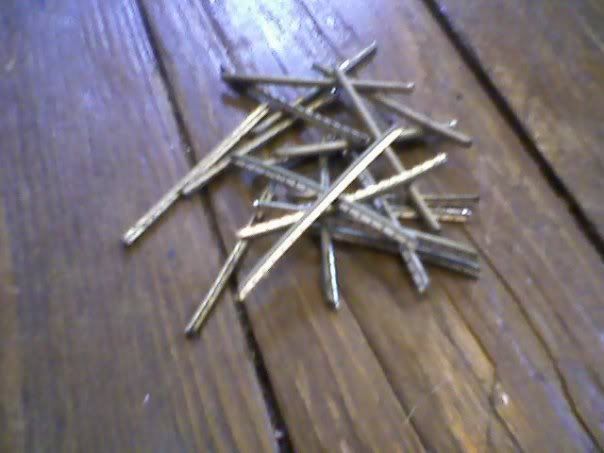
Some frets on, some frets off: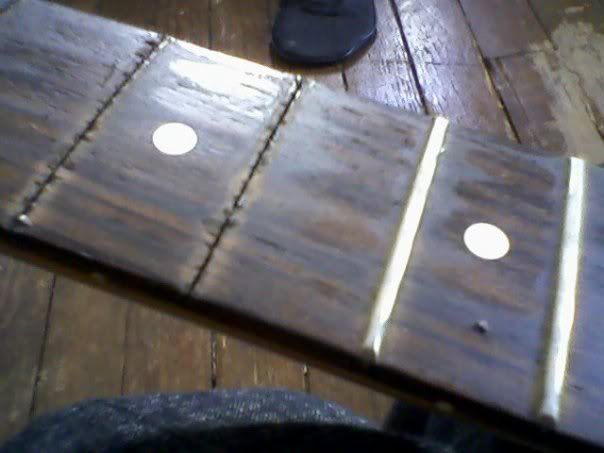
A closeup of th neck. You can see dark slots where th original frets used to sit: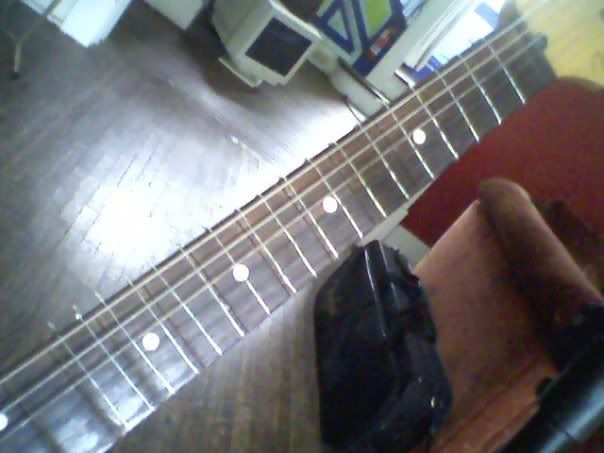
Th body of th guitar, w/ decorations left over from when th instrument belonged to teenage Andrew Heathwaite: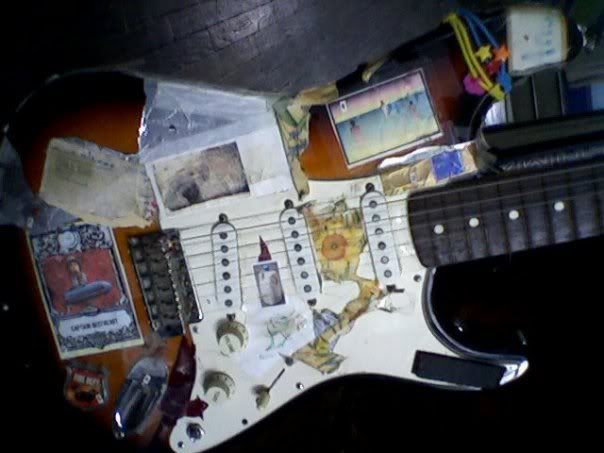
Why 22?
I like 22edo because it fits somewhere between very familiar & very strange. You can get some familiar sounds, eg. major chords (w/ more restful-sounding thirds, as 22edo thirds fall closer to th just third of 5:4). But you cannot build a direct analogue to a 12edo major scale. If you try to build a major scale w/ a circle of fifths, you get this:
0 4 8 9 13 17 21 0
Th third in this scale, at 8 degrees of 22, sounds much higher, brighter, than 12edo thirds. In fact, it sounds more like th septimal supermajor third, 9:7, which falls 35% of a half step (35 cents) above a 12edo major third. (That means 435 cents, instead of 400 cents.) This sounds very different & ear-bending.
Th 22edo major third, which comes much closer to 12edo & just, comes at th 7th degree, rather than th 8th (one degree below th supermajor third). It comes closer to just than 12edo does, which, as previously mentioned, makes it sound more restful. But, if we use it in our scale, look what happens:
0 4 7...
See how th major third gets sliced into two differently-sized intervals, a 4 degree interval & a 3 degree interval? That means that we effectively have two different major seconds to play around w/. That sounds odd to those of us accustomed to 12edo, where we have only one major second, but in just intonation, this kind of thing comes up frequently. Some other microtonal scales do what 12edo does, make those two different major seconds th same size. But 22edo does not.
This means that you can't build chord progressions in th same way. It forces you to do something xenharmonic. & that rocks.
22edo has other intervals that do get represented w/ th same step. Th 3 degree step, for example, can function as 10:9, 11:10, & 12:11 for example, which in just intonation would all sound a little different. In this way, it takes a complicated system & makes it simpler. But in a completely different way than 12edo does.
I could go on & on, but it will make even less sense to th uninitiated (& I have to leave soon for class!). But I'll give a few more reasons why I love 22edo.
- It contains 11edo, another wonderful scale!
- It contains several interesting moment-of-symmetry scales, including Orwell & Porcupine temperament.
- It demands smaller frets, but I still find them manageable. (A tuning w/ more notes might feel more awkward to play).
- It contains approximations of a few delightful higher-level JI intervals: 7:6, 11:8, 20:11.
- It has a bit of a following in th microtonal world. By writing music for this tuning, I would automatically have people interested in hearing it & playing it. Indeed, some 22edo guitars already exist (& most of them probably have real frets).
- It cannot play music conceived in 12edo!
I don't go for th "one true tuning" or "one new standard to replace th one old standard." I still love, for example, 17edo, & plan to continue writing & performing w/ it on th cumbus. I would like to invite other tunings into my life as well: Bohlen-Pierce, 14edo, 15edo, & eventually 31edo, for example. But 22edo calls to me now, so I answer.
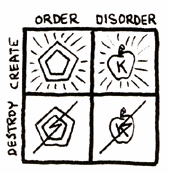

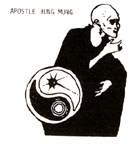


3 comments:
But, but, but... 23tET is the one true temperament.
I Get a Bass in 23-Tone Equalizated Scale (TES or tET or EDO) y es espectacularmente extraño. Coincido con EKSJAI en ke 23-TES es el únicus verdadero temperamento.
Volveré a modificar mi bajo a 22-EDO porke es dificultoso el afinar las cuerdas en escala de 23-EDO. Me ekivoké con mi comentario. Sospecho kel verdadero temperamento radica en la división hindú de la octava, o sea, en 22-EDO.
Post a Comment